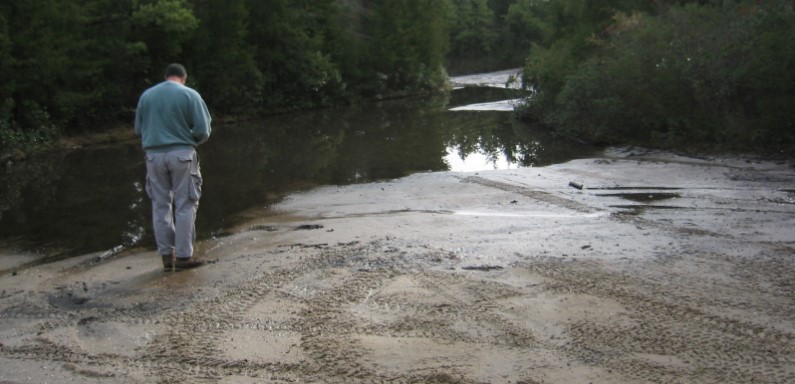The State We're In
Speak up for Wharton State Forest’s wildlife and water!
By Tom Gilbert, Co-Executive Director
At nearly 125,000 acres, or 194 square miles, Wharton State Forest is by far the largest tract of land within New Jersey’s state park system. It’s bigger than Essex and Hudson counties put together, and attracts over 800,000 visitors a year!
Located in the heart of the Pine Barrens, Wharton is remarkable for its diversity of wildlife, including threatened and endangered plants and animals like American chaffseed and Pine Barrens tree frogs. Hikers, birdwatchers, paddlers, photographers and other nature lovers are drawn to the forest’s beauty and serenity. The expansive landscape includes the headwaters of the Mullica and Batsto rivers and the Rancocas Creek.
Ever since the state acquired the land in the mid-1950s, the public has been allowed to travel nearly its entire network of sand roads in registered motor vehicles to explore the forest’s interior, visit historic ghost towns and find places to put in canoes and kayaks.
But in recent years, illegal motor vehicle use in Wharton has accelerated out of control. Irresponsible off-road vehicle (ORV) riders have damaged many of the old sand roads, illegally blazed new roads and trails through pristine forests and wetlands, and destroyed stream beds as part of the destructive hobbies known as “off-roading” and “mudding.”
The result is widespread damage to land and waterways, severely eroded stream banks, acres of denuded landscapes and cavernous mud pits that were once peaceful Pine Barrens wetlands and vernal pools. In addition to harming wildlife and degrading streams, ORV damage has made some roads so impassable that even powerful Forest Fire Service vehicles have gotten stuck.
“The ecosystem is just being torn up,” said Dr. Emile DeVito, New Jersey Conservation Foundation’s staff biologist. “It’s epidemic and it’s incredibly destructive.”
The New Jersey Department of Environmental Protection (DEP) is now revisiting the thorny issue of how to curb ORV damage in Wharton State Forest while still allowing law-abiding visitors to continue accessing the old sand roads in motor vehicles.
On Tuesday, Sept. 27, the DEP will hold a virtual public hearing that is anticipated to be the first in a series of outreach efforts.
“Public engagement is critical to our mission to ensure the forest is a place for everyone to enjoy,” said DEP Commissioner Shawn LaTourette. “We therefore encourage the public and stakeholders to participate in our virtual sessions and complete the survey to ensure a diversity of viewpoints.”
Back in 2015, the state proposed a new map showing which roads within Wharton would be designated for motorized access, and which would be set aside exclusively for visitors on foot, bicycles and horses. However, the plan was shelved after the state received a storm of complaints from many off-road vehicle groups and other recreational groups that want unrestricted vehicular access to every corner of the forest.
The Sept. 27 meeting, which begins at 6 p.m., will include a demonstration of a new web-based survey and mapping tool allowing park users to answer questions about their favorite recreational activities in Wharton State Forest, such as fishing, hiking, boating and scenic driving. The survey will allow participants to mark areas of importance on the interactive mapping tool, including natural and historic resources and places of personal significance. Public input will also be accepted by mail or email.
“Understanding how, when and where people recreate throughout Wharton State Forest is key for the State Park Service to develop plans that are representative of the diverse users who come to visit from around the state and country, while protecting this nationally recognized unique environment,” said John Cecil, Assistant Commissioner of State Parks, Forests & Historic Sites.
Survey results will be used “to clearly define designated safe and legal routes for vehicle usage, while protecting culturally and ecologically sensitive areas,” the DEP said. The new mapping will also serve as a model for protection of other state-managed lands throughout the Pinelands that are being harmed by illegal ORV use.
In 2021, the state Attorney General’s Office secured an increase in fines for illegal ORV use and damages. If a violation results in damage to or destruction of natural resources, an additional fine of five times the cost of the damage may be assessed. According to the DEP, efforts to curb illegal off-road vehicle activity are being stepped up.
But currently law enforcement staff appear to be too few – and in far too many cases, too lenient – to be effective.
Conservationists are calling for:
- Scientifically-based limits on which existing sand roads will remain accessible for registered vehicle travel, via the development of an official map for legal vehicular access within Wharton State Forest.
- Stronger enforcement of long-ignored regulations governing ORV use on public lands.
If you care about Wharton State Forest and its plant and animal communities, please participate in this important public survey! The first step is to register for the Sept. 27 meeting at http://njparksandforests.org/wharton/. The link also includes information on the survey and other public outreach efforts.
To learn more about Wharton State Forest and its many resources, go to https://nj.gov/dep/parksandforests/parks/whartonstateforest.html.
For information about the “Fix Our Parks” initiative to improve state parks, forests and recreation areas, go to www.fixourparksnj.org/. The initiative was founded by four New Jersey nonprofits: the Pinelands Preservation Alliance, New Jersey Conservation Foundation, Highlands Coalition and NY NJ Trail Conference.
And to learn more about preserving New Jersey’s land and natural resources, visit the New Jersey Conservation Foundation website at www.njconservation.org or contact me at info@njconservation.org.
About the Authors
Alison Mitchell
Executive Director
Michele S. Byers
Executive Director, 1999-2021
John S. Watson, Jr.
Co-Executive Director, 2022-2024
Tom Gilbert
Co-Executive Director, 2022-2023
View their full bios here.
Filter
Get The Latest News
From The Garden State
In the
News

